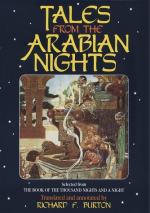[FN#305] So in old Arabian history “Kas¡r” (the Little One), the Arab Zopyrus, stows away in huge camel-bags the 2,000 warriors intended to surprise masterful Queen Zebba. Chronique de Tabar¡, vol. ii., 26. Also the armed men in boxes by which Shamar, King of Al-Yaman, took Shamar-kand = Shamar’s-town, now Samarkand. (Ibid. ii. 158.)
[FN#306] i.e. for a walk, a “constitutional”: the phrase is very common in Egypt, and has occurred before.
[FN#307] These visions are frequent in Al-Islam; see Pilgrimage iii. 254-55. Of course Christians are not subject to them, as Moslems also are never favoured with glimpses of the Blessed Virgin and the Saints; the best proof of their “Subjectivity.”
[FN#308] For this word see De Sacy, Chrest. ii. 421. It has already occurred in The Nights, vol. iii. 295.
[FN#309] Not a few pilgrims settle for a time or for life in the two Holy Places, which are thus kept supplied with fresh blood. See Pilgrimage ii. 260.
[FN#310] i.e. Bayt al-Mukaddas, for which see vol. ii. 132.
[FN#311] An affidavit amongst Moslems is “litis decisio,” as in the jurisprudence of mediaeval Europe.
[FN#312] In Arab folk-lore there are many instances of such precocious boys—enfants terribles they must be in real life. In Ibn Khall. (iii. 104) we find notices of a book “Kitab Nujaba al-Abna” = Treatise on Distinguished Children, by Ibn Zakar al-Sakalli (the Sicilian), ob. A. D. 1169-70. And the boy-Kazi is a favourite role in the plays of peasant-lads who enjoy the irreverent “chaff” almost as much as when “making a Pasha.” This reminds us of the boys electing Cyrus as their King in sport (Herodotus, i. 114). For the cycle of “Precocious Children” and their adventures, see Mr. Clouston (Popular Tales, etc., ii. 1- 14), who enters into the pedigree and affiliation. I must, however, differ with that able writer when he remarks at the end, “And now we may regard the story of Valerius Maximus with suspicion, and that of Lloyd as absolutely untrue, so far as William Noy’s alleged share in the ‘case.’ " The jest or the event happening again and again is no valid proof of its untruth; and it is often harder to believe in derivation than in spontaneous growth.
[FN#313] In Galland Ali Cogia, Marchand de Bagdad, is directly followed by the Histoire du Cheval Enchante. For this “Ebony Horse,” as I have called it, see vol. v. p. 32.
[FN#314] “Banu” = a lady, a dame of high degree generally, e.g. the (Shah’s) Banu-i-Harem in James Morier ("The Mirza,” iii. 50), who rightly renders Pari Banu = Pari of the first quality. “Peri” (Pari) in its modern form has a superficial resemblance to “Fairy;” but this disappears in the “Pairika” of the Avesta and the “Pairik” of the modern Parsee. In one language only, the Multani, there is a masculine form for the word “Para” = a he-fairy (Scinde, ii. 203). In Al-Islam these




